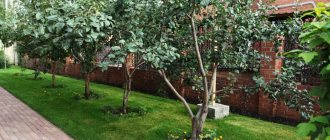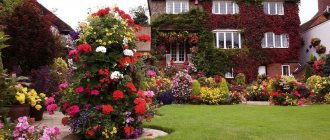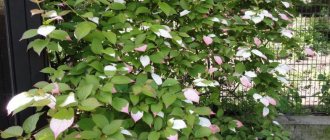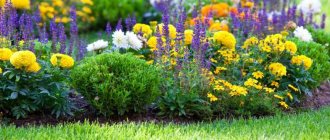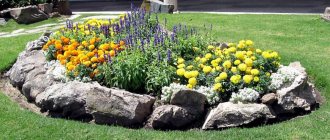It’s always interesting to create something new, and even more so to create an individual design for your site. In the process of choosing what to plant in a flower bed near the house, we are guided by two principles:
- Tall plants are planted in the center of the flowerbed;
- along the edges of the flower beds - low.
It is important that the flower bed pleases the eye from early spring until frost, the flowers should replace each other according to the timing of flowering. For this, spring primroses, perennials (phlox, peonies, lilies) and annual plants are used. The main composition is made from perennial plants, and the rest of the flowers complement them.
Bulbs and cereals for flower beds
The appearance of the area around the house depends on what plants you plant in the yard. If you choose the right flowers, they will replace each other - when some fade, others will bloom, and the flowerbed will retain its decorative appearance. Some types of plants look spectacular even in winter.
In flower beds in local areas you can plant annuals and perennials, bulbous plants and low shrubs. Ornamental cereals and herbs are suitable for decorating flower beds. You can plant conifers on lawns - dwarf and creeping species will look especially good.
Bulbs are the first to appear in a flower bed - snowdrops bloom as soon as the snow begins to melt. They are being replaced by crocuses, muscari and hyacinths. In May, tulips and daffodils bloom, followed by anemones, irises and lilies. Garden callas bloom all summer. Closer to autumn, gladioli and dahlias bloom.
You should not pick leaves and stems of faded plants: the bulbs need them to bloom next spring. Over the summer, the bulbs must grow and accumulate nutrients, but without leaves they will not be able to do this.
At the same time as bulbous plants, ornamental cereal plants appear in flower beds and lawns. These are unpretentious plants, resistant to diseases and pests. They easily get along with various crops and tolerate both lack and excess of moisture. Cereals come in different heights and colors. They are planted along the edges of flower beds, on alpine hills and lawns. They look good at any time of the year:
- In early spring there is fresh young greenery and picturesque clumps.
- In summer, grasses grow and form various inflorescences - ears and panicles.
- Curtains covered with snow look spectacular in winter.
Suitable for flower beds: striped phalaris grass, haretail, pinnately bristle grass, setaria, cortaderia, feather grass and many other plants. In addition to cereals, you can grow herbs in flower beds and lawns: mint, oregano, basil.
Spring primroses
These flowers are the first to announce that spring has arrived. And some of them are able to bloom even during the winter thaw. Most of them are low-growing bulbous plants, but there are also herbaceous perennials.
Several species of plants in this group:
- Primrose;
- Snowdrop;
- Crocus;
- Grouse;
- Scilla;
- Pushkinia;
- Anemone;
- Chionodoxa;
- Narcissus;
- Tulip.
The main difference between this group is the short growing season. Immediately after flowering, their leaves begin to dry out and by the beginning - mid-June they are no longer there.
A border of daffodils will delight only in the spring, but the area exposed after flowering can be covered by perennials - peonies, rudbeckia, echinacea; they begin to grow intensively just when the flowering of early bulbous plants comes to an end.
Rabatka from Pushkinia.
Container garden. When the tulips fade, they can be easily replaced with containers of other crops.
Perennial flowering plants
Perennials are very convenient to grow in flower beds - you do not need to worry about seeds, seedlings and preparing the soil for planting every year. Many of them are unpretentious and bloom all summer. Such plants include:
- cornflowers;
- lobelia;
- perennial flax;
- aquilegia;
- garden tradescantia;
- yarrow;
- arabis;
- astilbe;
- delphinium and many others.
Roses require more care: they need to be regularly pruned, loosened and fed. They must be covered for the winter. Roses pay for their care with magnificent blooms that last all summer. At the end of the summer season, when many plants have finished blooming, autumn chrysanthemums bloom. They bloom until frost and fit perfectly into the garden composition.
Against the background of greenery, garden daisies look great and can decorate any yard. They are unpretentious: they tolerate drought well and do not require close attention. There are different varieties of daisies: large cornflower, red and pink pyrethrum, yellow doronicum. There are even terry varieties, similar to asters and chrysanthemums. Daisies combine well with other perennials and small shrubs.
A good addition to other plants that grow in the yard is gypsophila. This is an unpretentious flower, perennial varieties of which grow in one place for 25-30 years. Gypsophila is easy to care for - just water and feed occasionally.
Pelargonium is usually grown as a houseplant, but in the summer it can be transplanted into an outdoor flower bed. It develops well on the sunny side and produces many inflorescences in open ground. In order to grow pelargonium next year, you need to cut several cuttings and plant them at home.
Main characteristics
In landscape design, there is a special class of herbs that either do not bloom at all or bloom unnoticed. These are ornamental herbaceous plants. Some look so impressive that it is no longer possible to imagine a modern flowerbed or front garden without them. There are a great many herbaceous plants in nature. There are about 18,000 of them in Russia alone. But of course, not all herbs can be classified as ornamental.
Herbaceous plants are plants that do not have perennial above-ground characteristics, they do not have woodiness of the stem, and at the end of the growing season they die off. Herbs form a root system and shoots: leaves, stem and flower part, if any.
Classification of herbaceous plants
Herbaceous plants are classified according to various criteria. But grouping plants by lifespan is considered the most convenient. Their examples:
- Annuals, after completing the growing season or flowering and fruiting, die off completely, without the possibility of resumption of growth. Such plants reproduce exclusively by seeds.
- Biennials complete their life cycle in two years. During the first season they develop shoots and roots. At the end of the growing season, their stem dies off in the same way as that of annuals, but the underground part survives to produce flowering shoots next year. Complete death occurs at the end of flowering.
- Perennials differ from biennials by the presence of rhizomes, bulbs or tubers, which have a longer renewal period. But their above-ground shoots die off in the same way when the growing season ends. After a year, under the influence of heat, new roots and young shoots sprout from living tissue.
Tall and low annuals
Annual flowers are suitable for those who like variety in their flower beds - they can be used to create picturesque compositions. Annuals are often planted in flowerpots and flowerpots. Everyone is well aware of the following names of plants in the yard that are planted every year:
- marigold;
- zinnias;
- asters;
- petunias;
- begonias;
- Snapdragon;
- poppies;
- calendula.
These flowering annuals are unpretentious and do not require much care. They grow quickly and bloom all summer.
Marigolds are one of the plant species most common in the middle zone. There are a large number of different marigolds: terry, smooth, chrysanthemum-shaped. Their color ranges from lemon yellow to dark brown. New varieties of flowers are constantly appearing. Marigolds have medicinal and insecticidal properties. They easily tolerate transplantation in a blooming state, which is why they are used to fill empty spaces in flower beds.
Zinnias are bright large flowers of various colors that look good in flower beds, rockeries and alpine hills. They prefer sunny places. Petunias, beautiful flowering plants of various shapes and colors, are extremely popular among designers. Low-growing varieties are used to decorate flower beds, and cascading varieties are grown in flowerpots.
Asters are also well-known and popular flowers. They bloom in summer and bloom until late autumn. There are many varieties of asters - low-growing and tall, simple and double. Suitable specimens can be selected for any flower garden.
Beautiful flowering perennials
This includes herbaceous perennials, bulbous plants and even shrubs. They bloom for a short time, with beautiful flowers, which are emphasized when planting them in a mixborder. It is desirable that the flower garden have one accent of such plants, but during the entire growing season, that is, it is necessary to select beautifully flowering perennials with different flowering periods.
Some types of plants in this group:
- Rose;
- Lily;
- Hydrangea;
- Clematis;
- Gladiolus;
- Dahlia;
- Iris;
- Colchicum;
- Tuberous begonias;
- Chrysanthemum;
- Imperial hazel grouse.
A composition in which luxurious tuberous begonias set the tone.
Autumn composition, which includes dahlias, geraniums, evergreen begonia, sedums.
Border of spherical chrysanthemums.
Flowers for borders
Low-growing flowers are used for planting along the edges of flower beds. They do not cover the plants planted behind them and do not spoil the overall appearance of the flower garden. The most popular of them are:
- pansies;
- periwinkle;
- purslane;
- primrose;
- Turkish cloves.
Pansies can be planted in shaded areas. These flowers come in a variety of colors, form lush bushes and serve as a good decoration for a flower bed. Turkish carnation grows quickly and covers the empty spaces of the flower garden. It has a subtle and delicate aroma. Small decorative carnation inflorescences delight all summer, and some species bloom again in the fall.
Purslane is suitable for planting in flower beds located in bright sun. This plant spreads along the ground and covers empty areas well. It grows quickly and blooms with beautiful bright flowers. Purslane is not only beautiful, but also edible - its young stems are used for salad.
Decorative leaf perennials
These plants are grown primarily for their beautiful foliage, although many also have beautiful flowers. They can serve as a background for other beautiful flowering plants. And you can create a composition only from them, playing with the color and texture of the leaves.
Some types of plants in this group:
- Hosta;
- Brunner;
- Chistets;
- Fern;
- Heuchera;
- Euonymus;
- Barberry;
- Asparagus;
- Sagebrush;
- Phalaris.
Most of these plants do not tolerate bright scorching sun, in which they lose their color; deep shade is also undesirable, especially for species with white and yellow patterns.
Wormwood 'Powis Castle'.
Phalaris curtains.
Asparagus, pictured is the variety Asparagus densiflorus Meyersii.
Flowering shrubs
Shrubs are traditionally used to decorate the area near the house. They require much less care than flowers. Shrubs can be either flowering or fruiting. The following unpretentious and frost-resistant plants are usually planted in home areas:
- Lilac, whose fragrant clusters bloom in early spring. Caring for it is simple - the bush is occasionally watered, fed and dry branches are cut off.
- Spiraea is a lush flowering shrub with spectacularly colored flowers and leaves. He is unpretentious and hardy. Spiraea is used in various landscaping options. You can choose varieties that bloom in both spring and autumn.
- Budleya is a shrub that blooms with large flowers of different shades of lilac. Flowering continues from July until late autumn. Immediately after its completion, the bush needs pruning.
- Hydrangea delights gardeners all summer with its large, elegant inflorescences. It needs regular feeding and mandatory pruning. The plant tolerates even the most severe frosts well and does not need shelter.
- Weigela blooms twice a year - in spring and late summer. Its flowers come in the form of white, pink, red and cream bells. This heat-loving shrub develops well in a dark place and needs shelter in winter.
- Deutzia is an exotic plant that recently appeared in our gardens. During flowering, it is completely strewn with small white, pink or brown flowers. Deutzia looks great against the backdrop of conifers and forms spectacular compositions in combination with other flowering plants.
- Thorn is a shrub whose fruits can be eaten. Its growth can reach three meters, so the plant must be pruned regularly. Blooming thorns give off a pleasant aroma.
- You can also plant rose hips, viburnum and hawthorn in your yard. These shrubs bloom beautifully in the spring, and bright and elegant fruits ripen on them in the fall. They are unpretentious in care and are highly frost-resistant.
What is a front garden
There is a small area between any private house and the sidewalk. It is called a front garden. The French word palissade means "fence, palisade." Flowering plants are often planted behind the fence and garden sculptures are installed. To make them pleasing to the eye, they try to be creative and show their taste.
Trees and conifers
Coniferous plants are often used to decorate houses. They purify the air and release beneficial essential oils. You should not choose tall varieties - it is better to limit yourself to dwarf specimens, the height of which does not exceed two meters. Coniferous plants in the courtyard of a house can be as follows:
- thuja;
- juniper;
- dwarf pine;
- spruce;
- cypress
Conifers form original compositions against the background of stones. They can be combined with ornamental cereals, flowering shrubs and herbaceous plants, such as hosta and ferns. Conifers are unpretentious and frost-resistant. They look good in winter. Dwarf varieties grow very slowly and do not require pruning.
Trees are a necessary element of the design of the local area. They protect homes from sun, dust and noise. Trees are essential in cities, where their leaves purify the air and absorb harmful chemicals. On a hot day they provide coolness, and in spring and summer they fill the air with the aroma of flowers.
But not every tree is suitable for planting on a home’s property—for example, plants with a strong root system can damage communications or the foundation. The following types are usually used for planting:
- Rowan - this tree will decorate any yard. For planting it, it is better to choose moist, shady places.
- Maple is a beautiful, fast-growing plant that has green foliage in the summer and turns yellow or purple in the fall.
- Linden is a shade-tolerant tree that blooms with pleasant-smelling flowers in summer.
- The apple tree blooms with delicate flowers in the spring and bears fruit in the fall. It has long been planted near houses.
In the local area you can also plant cherry, chestnut, poplar, birch, ash, bird cherry, and willow. At some distance from home you can grow spruce and pine. When planting, you should take into account that many trees grow very tall and block the light on the lower floors. They should not be planted close to the house.
Types of front gardens
Front gardens vary depending on the location of the fence and the plants in it.
- The open type consists of flower beds with compact plants or a lawn. They allow you to see the house from the road through the fence slats.
- The closed one is protected from prying eyes by a solid fence made of brick and metal or a hedge of suitable plants. Flowerbeds are not visible to strangers from the street.
- Covered is something in between of the above. Plants do not exceed the height of the fence, and taller plantings may be present in the corners of the fence.
- Formal is organized in cases where there cannot be planting between the house and the sidewalk. The local area begins immediately. In this case, a decorative flowerpot is installed right at the entrance to the building.

